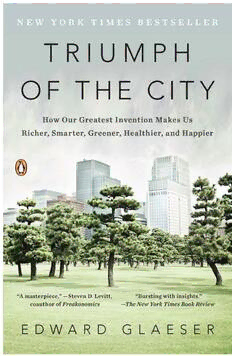
Triumph of the City: How Our Greatest Invention Makes Us Richer, Smarter, Greener, Healthier, and Happier PDF
Preview Triumph of the City: How Our Greatest Invention Makes Us Richer, Smarter, Greener, Healthier, and Happier
Table of Contents Title Page Copyright Page Dedication Introduction CHAPTER 1 - What Do They Make in Bangalore? CHAPTER 2 - Why Do Cities Decline? CHAPTER 3 - What’s Good About Slums? CHAPTER 4 - How Were the Tenements Tamed? CHAPTER 5 - Is London a Luxury Resort? CHAPTER 6 - What’s So Great About Skyscrapers? CHAPTER 7 - Why Has Sprawl Spread? CHAPTER 8 - Is There Anything Greener Than Blacktop? CHAPTER 9 - How Do Cities Succeed? CONCLUSION: Acknowledgements NOTES BIBLIOGRAPHY INDEX THE PENGUIN PRESS Published by the Penguin Group Penguin Group (USA) Inc., 375 Hudson Street, New York, New York 10014, U.S.A. • Penguin Group (Canada), 90 Eglinton Avenue East, Suite 700, Toronto, Ontario, Canada M4P 2Y3 (a division of Pearson Penguin Canada Inc.) • Penguin Books Ltd, 80 Strand, London WC2R 0RL, England • Penguin Ireland, 25 St. Stephen’s Green, Dublin 2, Ireland (a division of Penguin Books Ltd) • Penguin Books Australia Ltd, 250 Camberwell Road, Camberwell, Victoria 3124, Australia (a division of Pearson Australia Group Pty Ltd) • Penguin Books India Pvt Ltd, 11 Community Centre, Panchsheel Park, New Delhi—110 017, India • Penguin Group (NZ), 67 Apollo Drive, Rosedale, North Shore 0632, New Zealand (a division of Pearson New Zealand Ltd) • Penguin Books (South Africa) (Pty) Ltd, 24 Sturdee Avenue, Rosebank, Johannesburg 2196, South Africa Penguin Books Ltd, Registered Offices: 80 Strand, London WC2R 0RL, England First published in 2011 by The Penguin Press, a member of Penguin Group (USA) Inc. Copyright © Edwa rd Glaeser, 2011 All rights reserved LIBRARY OF CONGRESS CATALOGING-IN-PUBLICATION DATA Glaeser, Edward L. (Edward Ludwig),———. Triumph of the city : how our greatest invention makes us richer, smarter, greener, healthier, and happier / Edward L. Glaeser. p. cm. Includes bibliographical references and index. eISBN : 978-1-101-47567-6 1. Urbanization. 2. Cities and towns—Growth. 3. Urban economics. 4. Urban sociology. I. Title. HT361.G53 2011 307.76—dc22 2010034609 Without limiting the rights under copyright reserved above, no part of this publication may be reproduced, stored in or introduced into a retrieval system, or transmitted, in any form or by any means (electronic, mechanical, photocopying, recording or otherwise), without the prior written permission of both the copyright owner and the above publisher of this book. T he scanning, uploading, and distribution of this book via the Internet or via any other means without the permission of the publisher is illegal and punishable by law. Please purchase only authorized electronic editions and do not participate in or encourage electronic piracy of copyrightable materials. Your support of the author’s rights is appreciated. W hile the author has made every effort to provide accurate telephone numbers and Internet addresses at the time of publication, neither the publisher nor the author assumes any responsibility for errors, or for changes that occur after publication. Further, publisher does not have any control over and does not assume any responsibility for author or third-party Web sites or their content. http://us.penguingroup.com To Nancy, for All the Days INTRODUCTION: Our Urban Species Two hundred forty-three million Americans crowd together in the 3 percent of the country that is urban. Thirty-six million people live in and around Tokyo, the most productive metropolitan area in the world. Twelve million people reside in central Mumbai, and Shanghai is almost as large. On a planet with vast amounts of space (all of humanity could fit in Texas—each of us with a personal townhouse), we choose cities. Although it has become cheaper to travel long distances, or to telecommute from the Ozarks to Azerbaijan, more and more people are clustering closer and closer together in large metropolitan areas. Five million more people every month live in the cities of the developing world, and in 2011, more than half the world’s population is urban. Cities, the dense agglomerations that dot the globe, have been engines of innovation since Plato and Socrates bickered in an Athenian marketplace. The streets of Florence gave us the Renaissance, and the streets of Birmingham gave us the Industrial Revolution. The great prosperity of contemporary London and Bangalore and Tokyo comes from their ability to produce new thinking. Wandering these cities—whether down cobblestone sidewalks or grid-cutting cross streets, around roundabouts or under freeways—is to study nothing less than human progress. In the richer countries of the West, cities have survived the tumultuous end of the industrial age and are now wealthier, healthier, and more alluring than ever. In the world’s poorer places, cities are expanding enormously because urban density provides the clearest path from poverty to prosperity. Despite the technological breakthroughs that have caused the death of distance, it turns out that the world isn’t flat; it’s paved. The city has triumphed. But as many of us know from personal experience, sometimes city roads are paved to hell. The city may win, but too often its citizens seem to lose. Every urban childhood is shaped by an onrush of extraordinary people and experiences—some delicious, like the sense of power that comes from a preteen’s first subway trip alone; some
